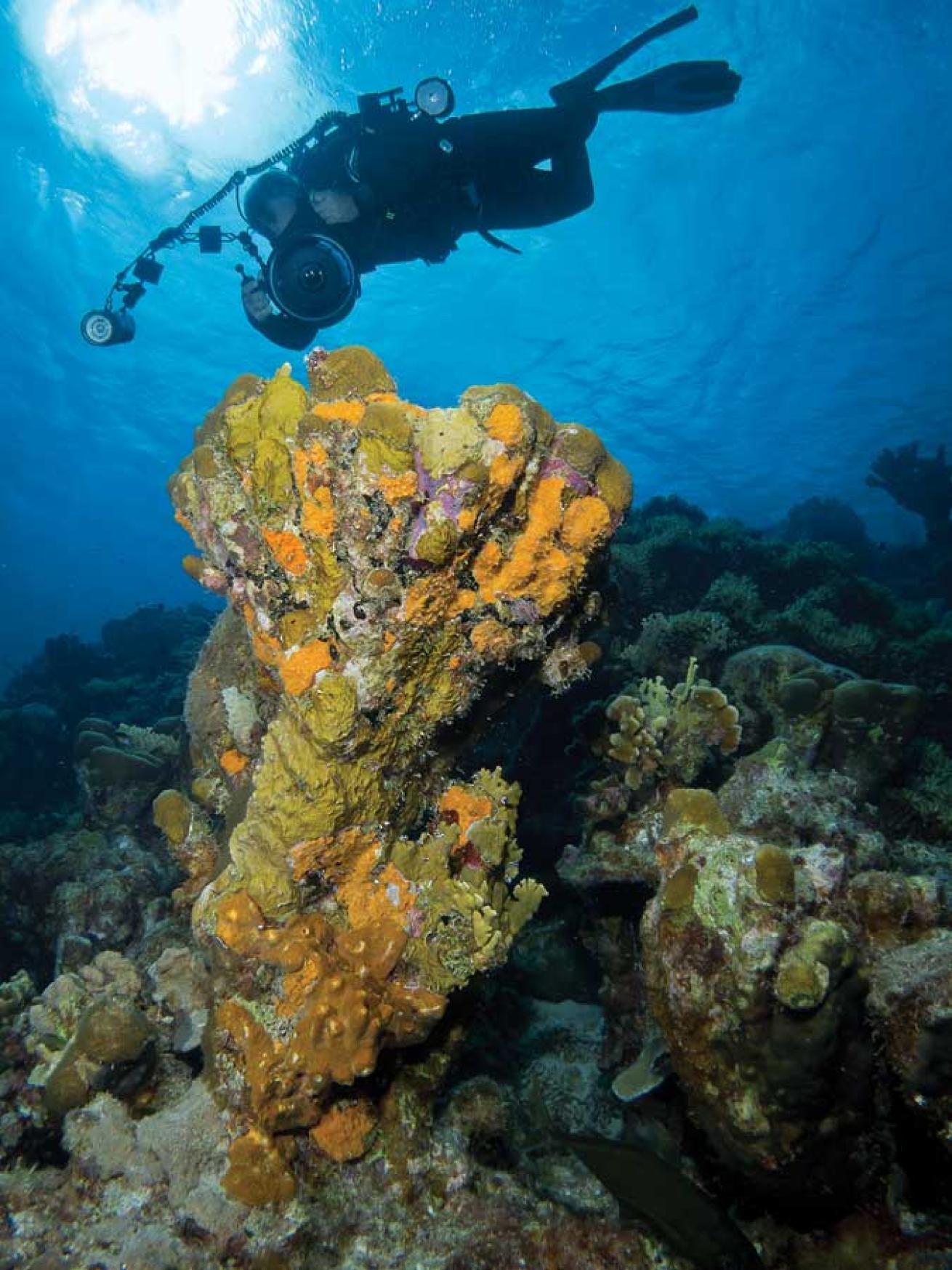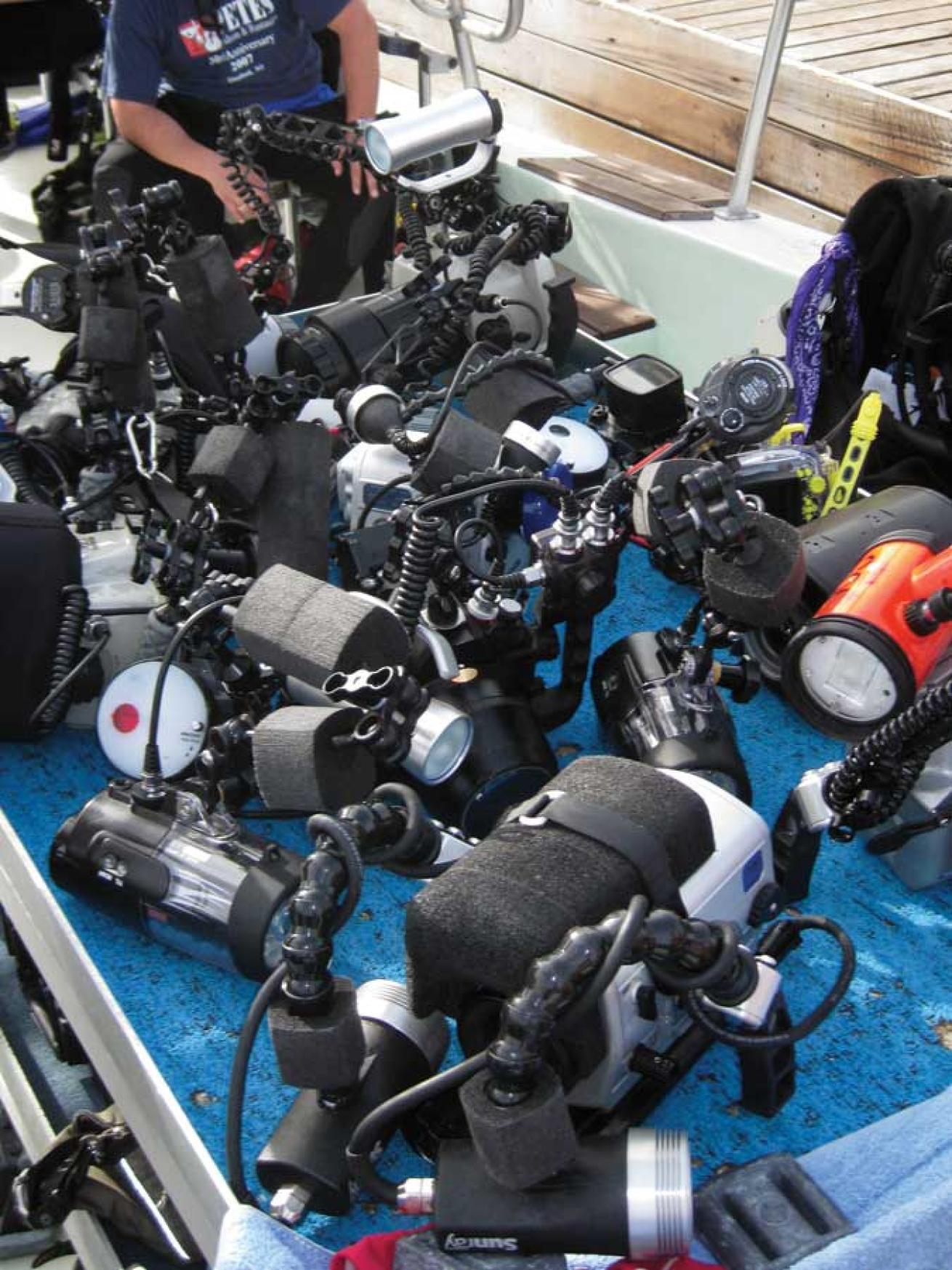Imaging Plus: Mind Your Manners
Part of being a good underwater photographer is being a good diver first. Use these tips to get the best shots, and also to protect the reef.
Get Yourself Neutral
Operating a camera underwater requires a diver to remain in steady positions for extended periods of time. This can be extremely difficult if the diver is overweighted, rolling around with an overinflated bag of air on his or her back. Only a thin suit is needed for diving in tropical waters — Bonaire, for example — so you should need to add only a very minimal amount of air to your BC, if any at all.
Get Your Camera Neutral
If your camera is negatively buoyant, it’s going to throw of your trim in the water and make it difficult to set up for a shot. There are flotation devices on the market for cameras of all types to get your rig neutral, which will make a huge diference in making the shot easier to get.
Become a Stalker
Like a hunter, you need to stalk your prey. If you get excited and quickly swim up to a subject, you might spook it, and it will take of. A slow, steady approach, letting the subject get used to your presence, will lead to more success. Also anticipate where the subject is going to be, not where it is.
Use One Finger for Stability and Sush Off
Underwater photographers need to get very close to the subjects they are photographing, often without a clear path of retreat. Use one finger, and find a piece of rock or a sandy area from which to push of until you can clear the reef and swim. If you find yourself accidentally on the reef, do not try to swim off — this will only create more damage. Instead, push of with one finger, and swim around for another try.
Clip it Off
Get a reliable lanyard for your camera, and clip it to your BC. Not only will this ensure that it doesn’t fall to the depths, never to been seen again, but if there is a situation that requires your complete attention — such as deploying a surface-marker buoy in current — you can devote your full attention to the issue at hand while your camera hangs safely from your BC.
Behind the Lens
[GEAR] Panasonic LX-5, Nauticam housing, Inon Z-240 strobes, Inon UWL-H100 wide lens
[CAMERA SPECS] ISO 100 Shutter Seed 1/250 F-STOP 8
[LOCATION: Bonaire, Dutch Caribbean] The direction of the slope of the west-side reef makes for getting great sun-ball shots in the morning.
[CHALLENGES] Bonaire has rocky shore entries, so help your buddy with cameras while you both gear up.
More on Underwater Photography:
Out of the Box: Camera Housing | Perfecting Sun Balls | Taking Over/Under Images

Jim DeckerI was diving with my friend Chris when he saw me setting up for this shot. I gave him a few quick hand signals, then I lined up the coral pillar, Chris and the sun ball for the shot.

Jennifer Penner
- On the boat, keep your camera gear in designated areas.
- Avoid getting water on the camera table and keep it clear of other dive gear.
- Ask the crew to hand your camera to you after you’ve entered the water, and follow any special instructions they have.
- Don’t lie on the reef — use sand patches or dead rock to balance yourself.
- Be mindful of time spent on a subject — enough for three to four shots — before yielding to others.
- Don’t disturb other divers when setting up for a shot.
- Don’t harass, stress or move your subjects.
- Share your images with other divers on the boat.
Part of being a good underwater photographer is being a good diver first. Use these tips to get the best shots, and also to protect the reef.
Get Yourself Neutral
Operating a camera underwater requires a diver to remain in steady positions for extended periods of time. This can be extremely difficult if the diver is overweighted, rolling around with an overinflated bag of air on his or her back. Only a thin suit is needed for diving in tropical waters — Bonaire, for example — so you should need to add only a very minimal amount of air to your BC, if any at all.
Get Your Camera Neutral
If your camera is negatively buoyant, it’s going to throw of your trim in the water and make it difficult to set up for a shot. There are flotation devices on the market for cameras of all types to get your rig neutral, which will make a huge diference in making the shot easier to get.
Become a Stalker
Like a hunter, you need to stalk your prey. If you get excited and quickly swim up to a subject, you might spook it, and it will take of. A slow, steady approach, letting the subject get used to your presence, will lead to more success. Also anticipate where the subject is going to be, not where it is.
Use One Finger for Stability and Sush Off
Underwater photographers need to get very close to the subjects they are photographing, often without a clear path of retreat. Use one finger, and find a piece of rock or a sandy area from which to push of until you can clear the reef and swim. If you find yourself accidentally on the reef, do not try to swim off — this will only create more damage. Instead, push of with one finger, and swim around for another try.
Clip it Off
Get a reliable lanyard for your camera, and clip it to your BC. Not only will this ensure that it doesn’t fall to the depths, never to been seen again, but if there is a situation that requires your complete attention — such as deploying a surface-marker buoy in current — you can devote your full attention to the issue at hand while your camera hangs safely from your BC.
Behind the Lens
[GEAR] Panasonic LX-5, Nauticam housing, Inon Z-240 strobes, Inon UWL-H100 wide lens
[CAMERA SPECS] ISO 100 Shutter Seed 1/250 F-STOP 8
[LOCATION: Bonaire, Dutch Caribbean] The direction of the slope of the west-side reef makes for getting great sun-ball shots in the morning.
[CHALLENGES] Bonaire has rocky shore entries, so help your buddy with cameras while you both gear up.
More on Underwater Photography:
Out of the Box: Camera Housing | Perfecting Sun Balls | Taking Over/Under Images










